Identifying Evacuation Needs and Resources Based on Volunteered Geographic Information: A Case of the Rainstorm in July 2021, Zhengzhou, China
Abstract
1. Introduction
1.1. Background
1.2. Recent Trends for Rainstorm Research
2. Materials and Methods
2.1. Study Site
2.2. Collection and Processing of VGI Data and Indicators
2.3. Methods
3. Results
3.1. Textual Analysis
3.1.1. Keywords and Sentiments in SOS Messages
3.1.2. Topics of SOS Messages
3.2. Importance of Ranking Indicators and Selection of Forecasting Models
3.3. Optimization of Disaster Prevention through Identifying More Potential Evacuation Resource Locations
4. Discussion
5. Conclusions
Author Contributions
Funding
Institutional Review Board Statement
Informed Consent Statement
Data Availability Statement
Acknowledgments
Conflicts of Interest
References
- Fang, J.; Hu, J.M.; Shi, X.W.; Zhao, L. Assessing disaster impacts and response using social media data in China: A case study of 2016 Wuhan rainstorm. Int. J. Disaster Risk Reduct. 2019, 34, 275–282. [Google Scholar] [CrossRef]
- Wang, B.; Loo, B.P.Y.; Zhen, F.; Xi, G.L. Urban resilience from the lens of social media data: Responses to urban flooding in Nanjing, China. Cities 2020, 106, 102884. [Google Scholar] [CrossRef]
- Guo, J.; Wu, X.H.; Wei, G. A new economic loss assessment system for urban severe rainfall and flooding disasters based on big data fusion. Environ. Res. 2020, 188, 109822. [Google Scholar] [CrossRef]
- Guan, M.; Sillanpää, N.; Koivusalo, H. Storm runoff response to rainfall pattern, magnitude and urbanization in a developing urban catchment. Hydrol. Process. 2016, 30, 543–557. [Google Scholar] [CrossRef]
- Yin, J.; Yu, D.P.; Yin, Z.; Liu, M.; He, Q. Evaluating the impact and risk of pluvial flash flood on intra-urban road network: A case study in the city center of Shanghai, China. J. Hydrol. 2016, 537, 138–145. [Google Scholar] [CrossRef]
- Zhang, X.Q.; Hu, M.C.; Chen, G.; Xu, Y.P. Urban rainwater utilization and its role in mitigating urban waterlogging problems—A case study in Nanjing, China. Water Resour. Manag. 2012, 26, 3757–3766. [Google Scholar] [CrossRef]
- Xiao, Y.; Li, B.Q.; Gong, Z.W. Real-time identification of urban rainstorm waterlogging disasters based on Weibo big data. Nat. Hazards 2018, 94, 833–842. [Google Scholar] [CrossRef]
- UNDRR. The Sendai Framework for Disaster Risk Reduction 2015–2030. Available online: https://www.undrr.org/publication/sendai-framework-disaster-risk-reduction-2015-2030 (accessed on 17 October 2022).
- Song, X.; Skupin, A.; Pottathil, A.; Culotta, A.; Zhang, H.; Akerkar, R.A.; Huang, H.; Guo, S.; Zhong, L.; Ji, Y.; et al. Big Data and Emergency Management: Concepts, Methodologies, and Applications. IEEE Trans. Big Data 2020, 8, 397–419. [Google Scholar] [CrossRef]
- Dusse, F.; Júnior, P.S.; Alves, A.T.; Novais, R.; Vieira, V.; Mendonça, M. Information Visualization for Emergency Management: A Systematic Mapping Study. Expert Syst. Appl. 2016, 45, 424–437. [Google Scholar] [CrossRef]
- Elwood, S.; Goodchild, M.F.; Sui, D.Z. Researching volunteered geographic information: Spatial data, geographic research, and new social practice. Ann. Assoc. Am. Geogr. 2012, 102, 571–590. [Google Scholar] [CrossRef]
- Goodchild, M.F.; Glennon, J.A. Crowdsourcing geographic information for disaster response: A research frontier. Int. J. Digit. Earth 2010, 3, 231–241. [Google Scholar] [CrossRef]
- Jonietz, D.; Antonio, V.; See, L.; Zipf, A. Highlighting current trends in volunteered geographic information. ISPRS Int. J. Geo-Inf. 2017, 6, 202. [Google Scholar] [CrossRef]
- Senaratne, H.; Mobasheri, A.; Ali, A.L.; Capineri, C.; Haklay, M. A review of volunteered geographic information quality assessment methods. Int. J. Geogr. Inf. Sci. 2017, 31, 139–167. [Google Scholar] [CrossRef]
- Olszewski, R.; Wendland, A. Digital Agora–Knowledge acquisition from spatial databases, geoinformation society VGI and social media data. Land Use Policy 2021, 109, 105614. [Google Scholar] [CrossRef]
- Parker, C.J.; May, A.; Mitchell, V. The role of VGI and PGI in supporting outdoor activities. Appl. Ergon. 2013, 44, 886–894. [Google Scholar] [CrossRef]
- Klonner, C.; Usón, T.J.; Aeschbach, N.; Höfle, B. Participatory mapping and visualization of local knowledge: An example from Eberbach, Germany. Int. J. Disaster Risk Sci. 2021, 12, 56–71. [Google Scholar] [CrossRef]
- Sterlacchini, S.; Bordogna, G.; Cappellini, G.; Voltolina, D. SIRENE: A spatial data infrastructure to enhance communities’ resilience to disaster-related emergency. Int. J. Disaster Risk Sci. 2018, 9, 129–142. [Google Scholar] [CrossRef]
- Horita, F.E.A.; Degrossi, L.C.; De Assis, L.F.G.; Zipf, A.; de Albuquerque, J.P. The use of volunteered geographic information (VGI) and crowdsourcing in disaster management: A systematic literature review. In Proceedings of the Nineteenth Americas Conference on Information Systems, Chicago, IL, USA, 15–17 August 2013; Volume 2013. [Google Scholar]
- Spinsanti, L.; Ostermann, F. Automated geographic context analysis for volunteered information. Appl. Geogr. 2013, 43, 36–44. [Google Scholar] [CrossRef]
- Foody, G.M.; See, L.; Fritz, S.; van der Velde, M.; Perger, C.; Schill, C.; Boyd, D.S.; Comber, A. Accurate attribute mapping from volunteered geographic information: Issues of volunteer quantity and quality. Cartogr. J. 2015, 52, 336–344. [Google Scholar] [CrossRef]
- Kankanamge, N.; Yigitcanlar, T.; Goonetilleke, A.; Kamruzzaman, M. Can volunteer crowdsourcing reduce disaster risk? A systematic review of the literature. Int. J. Disaster Risk Reduct. 2019, 35, 101097. [Google Scholar] [CrossRef]
- Haworth, B.; Bruce, E. A review of volunteered geographic information for disaster management. Geogr. Compass 2015, 9, 237–250. [Google Scholar] [CrossRef]
- Middleton, S.E.; Middleton, L.; Modafferi, S. Real-time crisis mapping of natural disasters using social media. IEEE Intell. Syst. 2014, 29, 9–17. [Google Scholar] [CrossRef]
- Kusumo, A.N.L.; Reckien, D.; Verplanke, J. Utilising volunteered geographic information to assess resident’s flood evacuation shelters. Case study: Jakarta. Appl. Geogr. 2017, 88, 174–185. [Google Scholar] [CrossRef]
- Moghadas, M.; Rajabifard, A.; Fekete, A.; Kötter, T. A framework for scaling urban transformative resilience through utilizing volunteered geographic information. ISPRS Int. J. Geo-Inf. 2022, 11, 114. [Google Scholar] [CrossRef]
- Haworth, B.T.; Bruce, E.; Whittaker, J.; Read, R. The good, the bad, and the uncertain: Contributions of volunteered geographic information to community disaster resilience. Front. Earth Sci. 2018, 6, 183. [Google Scholar] [CrossRef]
- Tzavella, K.; Fekete, A.; Fiedrich, F. Opportunities provided by geographic information systems and volunteered geographic information for a timely emergency response during flood events in Cologne, Germany. Nat. Hazards 2018, 91, 29–57. [Google Scholar] [CrossRef]
- Granell, C.; Ostermann, F.O. Beyond data collection: Objectives and methods of research using VGI and geo-social media for disaster management. Comput. Environ. Urban Syst. 2016, 59, 231–243. [Google Scholar] [CrossRef]
- Hung, K.C.; Kalantari, M.; Rajabifard, A. Methods for assessing the credibility of volunteered geographic information in flood response: A case study in Brisbane, Australia. Appl. Geogr. 2016, 68, 37–47. [Google Scholar] [CrossRef]
- Yuan, J.Y.; Roy Chowdhury, P.K.R.; Mckee, J.; Yang, H.L.; Weaver, J.; Bhaduri, B. Exploiting deep learning and volunteered geographic information for mapping buildings in Kano, Nigeria. Sci. Data 2018, 5, 180217. [Google Scholar] [CrossRef]
- Arapostathis, S.G. A methodology for automatic acquisition of flood-event management information from social media: The flood in Messinia, South Greece, 2016. Inf. Syst. Front. 2021, 23, 1127–1144. [Google Scholar] [CrossRef]
- Feng, Y.; Sester, M. Extraction of pluvial flood relevant volunteered geographic information (VGI) by deep learning from user generated texts and photos. ISPRS Int. J. Geo-Inf. 2018, 7, 39. [Google Scholar] [CrossRef]
- Mccallum, I.; Liu, W.; See, L.; Mechler, R.; Keating, A.; Hochrainer-Stigler, S.; Mochizuki, J.; Fritz, S.; Dugar, S.; Arestegui, M.; et al. Technologies to support community flood disaster risk reduction. Int. J. Disaster Risk Sci. 2016, 7, 198–204. [Google Scholar] [CrossRef]
- Yu, J.; Zhao, Q.S.; Chin, C.S. Extracting typhoon disaster information from VGI based on machine learning. J. Mar. Sci. Eng. 2019, 7, 318. [Google Scholar] [CrossRef]
- Klonner, C.; Marx, S.; Usón, T.; Porto de Albuquerque, J.P.; Höfle, B. Volunteered geographic information in natural hazard analysis: A systematic literature review of current approaches with a focus on preparedness and mitigation. ISPRS Int. J. Geo-Inf. 2016, 5, 103. [Google Scholar] [CrossRef]
- Quan, R.S. Rainstorm waterlogging risk assessment in central urban area of Shanghai based on multiple scenario simulation. Nat. Hazards 2014, 73, 1569–1585. [Google Scholar] [CrossRef]
- Yin, Z.E.; Yin, J.; Xu, S.Y.; Wen, J.H. Community-based scenario modelling and disaster risk assessment of urban rainstorm waterlogging. J. Geogr. Sci. 2011, 21, 274–284. [Google Scholar] [CrossRef]
- Su, B.N.; Huang, H.; Li, Y.T. Integrated simulation method for waterlogging and traffic congestion under urban rainstorms. Nat. Hazards 2016, 81, 23–40. [Google Scholar] [CrossRef]
- Lin, T.; Liu, X.; Song, J.; Zhang, G.; Jia, Y.; Tu, Z.; Zheng, Z.; Liu, C. Urban waterlogging risk assessment based on internet open data: A case study in China. Habitat Int. 2018, 71, 88–96. [Google Scholar] [CrossRef]
- Liu, Y.Y.; Li, L.; Zhang, W.H.; Chan, P.W.; Liu, Y.S. Rapid identification of rainstorm disaster risks based on an artificial intelligence technology using the 2DPCA method. Atmos. Res. 2019, 227, 157–164. [Google Scholar] [CrossRef]
- Liu, Y.Y.; Li, L.; Liu, Y.S.; Chan, P.W.; Zhang, W.H. Dynamic spatial-temporal precipitation distribution models for short-duration rainstorms in Shenzhen, China based on machine learning. Atmos. Res. 2020, 237, 104861. [Google Scholar] [CrossRef]
- Su, X.; Shao, W.W.; Liu, J.H.; Jiang, Y.Z.; Wang, K.B. Dynamic assessment of the impact of flood disaster on economy and population under extreme rainstorm events. Remote Sens. 2021, 13, 3924. [Google Scholar] [CrossRef]
- Hou, J.M.; Zhou, N.; Chen, G.Z.; Huang, M.; Bai, G.B. Rapid forecasting of urban flood inundation using multiple machine learning models. Nat. Hazards 2021, 108, 2335–2356. [Google Scholar] [CrossRef]
- Henan Government. Provincial Situation: Henan Overview (EB/OL). 2021. Available online: https://www.henan.gov.cn/2018/05-31/2408.html (accessed on 18 March 2022).
- The State Council of the People’s Republic of China, Circular of the State Council on Adjusting the Criteria for the Classification of City Sizes (EB/OL). 2014. Available online: http://www.gov.cn/zhengce/content/2014-11/20/content_9225.htm (accessed on 18 March 2022).
- Zhu, Y.; Zhang, C.; Fang, J.; Miao, Y. Paths and strategies for a resilient megacity based on the water-energy-food nexus. Sustain. Cities Soc. 2022, 82, 103892. [Google Scholar] [CrossRef]
- Wang, H.; Hu, Y.; Guo, Y.; Wu, Z.; Yan, D. Urban flood forecasting based on the coupling of numerical weather model and stormwater model: A case study of Zhengzhou city. J. Hydrol. Reg. Stud. 2022, 39, 100985. [Google Scholar] [CrossRef]
- Zhang, J.; Zhang, H.; Fang, H. Study on urban rainstorms design based on multivariate secondary return period. Water Resour. Manag. 2022, 36, 2293–2307. [Google Scholar] [CrossRef]
- Zhang, Y.; Chen, Z.; Zheng, X.; Chen, N.; Wang, Y. Extracting the location of flooding events in urban systems and analyzing the semantic risk using social sensing data. J. Hydrol. 2021, 603, 127053. [Google Scholar] [CrossRef]
- Ministry of Emergency Management of the People’s Republic of China, Investigation Report on “7.20” Heavy Rainstorm Disaster in Zhengzhou, Henan. Available online: https://www.mem.gov.cn/gk/sgcc/tbzdsgdcbg/202201/P020220121639049697767.pdf (accessed on 1 March 2022).
- Wu, W.J.; Li, J.L.; He, Z.Y.; Ye, X.X.; Zhang, J.; Cao, X.; Qu, H.J. Tracking spatio-temporal variation of geo-tagged topics with social media in China: A case study of 2016 Hefei rainstorm. Int. J. Disaster Risk Reduct. 2020, 50, 101737. [Google Scholar] [CrossRef]
- Wu, M.; Wu, Z.; Ge, W.; Wang, H.; Shen, Y.; Jiang, M. Identification of sensitivity indicators of urban rainstorm flood disasters: A case study in China. J. Hydrol. 2021, 599, 126393. [Google Scholar] [CrossRef]
- Yang, S.N.; Yin, G.F.; Shi, X.W.; Liu, H.; Zou, Y. Modeling the adverse impact of rainstorms on a regional transport network. Int. J. Disaster Risk Sci. 2016, 7, 77–87. [Google Scholar] [CrossRef]
- Zhou, L.; Wu, X.H.; Ji, Z.H.; Gao, G. Characteristic analysis of rainstorm-induced catastrophe and the countermeasures of flood hazard mitigation about Shenzhen city. Geomat. Nat. Hazards Risk 2017, 8, 1886–1897. [Google Scholar] [CrossRef]
- Liao, X.L.; Xu, W.; Zhang, J.L.; Li, Y.; Tian, Y.G. Global exposure to rainstorms and the contribution rates of climate change and population change. Sci. Total Environ. 2019, 663, 644–653. [Google Scholar] [CrossRef] [PubMed]
- Yoo, G.; Hwang, J.H.; Choi, C. Development and application of a methodology for vulnerability assessment of climate change in coastal cities. Ocean Coast. Manag. 2011, 54, 524–534. [Google Scholar] [CrossRef]
- Ma, S.; Lyu, S.; Zhang, Y. Weighted clustering-based risk assessment on urban rainstorm and flood disaster. Urban Clim. 2021, 39, 39100974. [Google Scholar] [CrossRef]
- Hu, H. Rainstorm flash flood risk assessment using genetic programming: A case study of risk zoning in Beijing. Nat. Hazards 2016, 83, 485–500. [Google Scholar] [CrossRef]
- Chen, J.F.; Liu, L.M.; Pei, J.P.; Deng, M.H. An ensemble risk assessment model for urban rainstorm disasters based on random forest and deep belief nets: A case study of Nanjing, China. Nat. Hazards 2021, 107, 2671–2692. [Google Scholar] [CrossRef]
- Li, Z.; Zhang, Y.; Wang, J.; Ge, W.; Li, W.; Song, H.; Guo, X.; Wang, T.; Jiao, Y. Impact evaluation of geomorphic changes caused by extreme floods on inundation area considering geomorphic variations and land use types. Sci. Total Environ. 2021, 754, 142424. [Google Scholar] [CrossRef] [PubMed]
- Quan, R.S.; Liu, M.; Lu, M.; Zhang, L.J.; Wang, J.J.; Xu, S.Y. Waterlogging risk assessment based on land use/cover change: A case study in Pudong New Area, Shanghai. Environ. Earth Sci. 2010, 61, 1113–1121. [Google Scholar] [CrossRef]
- Wu, X.D.; Yu, D.P.; Chen, Z.Y.; Wilby, R.L. An evaluation of the impacts of land surface modification, storm sewer development, and rainfall variation on waterlogging risk in Shanghai. Nat. Hazards 2012, 63, 305–323. [Google Scholar] [CrossRef]
- Zhang, H.; Wang, X.R. Land-use dynamics and flood risk in the hinterland of the Pearl River Delta: The case of Foshan City. Int. J. Sustain. Dev. World Ecol. 2007, 14, 485–492. [Google Scholar] [CrossRef]
- Al-Hourani, A.; Kandeepan, S.; Jamalipour, A. Modeling air-to-ground path loss for low altitude platforms in urban environments. In Proceedings of the 2014 IEEE Global Communications Conference, Austin, TX, USA, 8–12 December 2014; pp. 2898–2904. [Google Scholar] [CrossRef]
- Xu, X.L. China GDP Spatial Distribution km Grid Dataset, Resource and Environmental Science Data Registration and Publication System. 2017. Available online: http://www.resdc.cn/DOI (accessed on 18 March 2022).
- Bondarenko, M.; Kerr, D.; Sorichetta, A.; Tatem, A.J. Census/projection-disaggregated gridded population datasets, adjusted to match the corresponding UNPD 2020 estimates, for 183 countries in 2020 using Built-Settlement Growth Model (BSGM) outputs. In WorldPop; University of Southampton: Southampton, UK, 2020. [Google Scholar] [CrossRef]
- Zhang, X.; Liu, L.; Zhao, T.; Gao, Y.; Chen, X.; Mi, J. GISD30: Global 30 m impervious-surface dynamic dataset from 1985 to 2020 using time-series Landsat imagery on the Google Earth Engine platform. Earth Syst. Sci. Data 2022, 14, 1831–1856. [Google Scholar] [CrossRef]
- Tian, H.; Gao, C.; Xiao, X.; Liu, H.; He, B.; Wu, H.; Wang, H.; Wu, F. SKEP: Sentiment knowledge enhanced pretraining for sentiment analysis. In Proceedings of the 58th Annual Meeting of the Association for Computational Linguistics, Online, 5–10 July 2020; Association for Computational Linguistics: Stroudsburg, PA, USA, 2020; pp. 4067–4076. [Google Scholar]
- Blei, D.M. Probabilistic topic models. Commun. ACM 2012, 55, 77–84. [Google Scholar] [CrossRef]
- Blei, D.M.; Ng, A.Y.; Jordan, M.I. Latent Dirichlet allocation. J. Mach. Learn. Res. 2003, 3, 993–1022. [Google Scholar]
- Breiman, L. Random forests. Mach. Learn. 2001, 45, 5–32. [Google Scholar] [CrossRef]
- Janitza, S.; Strobl, C.; Boulesteix, A.-L. An AUC-Based Permutation Variable Importance Measure for Random Forests. BMC Bioinform. 2013, 14, 119. [Google Scholar] [CrossRef]
- Harrell, F.E. Binary logistic regression. In Regression Modeling Strategies. Springer Series in Statistics; Springer: Berlin/Heidelberg, Germany, 2015; pp. 219–274. [Google Scholar] [CrossRef]
- Hsu, C.; Chang, C.; Lin, C. A Practical Guide to Support Vector Classification; Department of Computer Science and Information Engineering, National Taiwan University: Taipei, Taiwan, 2003. [Google Scholar]
- Mendez, K.M.; Reinke, S.N.; Broadhurst, D.I. A Comparative Evaluation of the Generalised Predictive Ability of Eight Machine Learning Algorithms across Ten Clinical Metabolomics Data Sets for Binary Classification. Metabolomics 2019, 15, 150. [Google Scholar] [CrossRef]
- Liang, P.; Xu, W.; Ma, Y.; Zhao, X.; Qin, L. Increase of elderly population in the rainstorm hazard areas of China. Int. J. Environ. Res. Public Health 2017, 14, 963. [Google Scholar] [CrossRef]
- Goodchild, M.F.; Li, L.N. Assuring the quality of volunteered geographic information. Spat. Stat. 2012, 1, 110–120. [Google Scholar] [CrossRef]
- Han, X.H.; Wang, J.L. Using social media to mine and analyze public sentiment during a disaster: A case study of the 2018 Shouguang city flood in China. ISPRS Int. J. Geo-Inf. 2019, 8, 185. [Google Scholar] [CrossRef]
- Yuan, F.X.; Li, M.; Liu, R. Understanding the evolutions of public responses using social media: Hurricane Matthew case study. Int. J. Disaster Risk Reduct. 2020, 51, 101798. [Google Scholar] [CrossRef]
- de Albuquerque, J.P.; Herfort, B.; Brenning, A.; Zipf, A. A geographic approach for combining social media and authoritative data towards identifying useful information for disaster management. Int. J. Geogr. Inf. Syst. 2015, 29, 667–689. [Google Scholar] [CrossRef]
- Rollason, E.; Bracken, L.J.; Hardy, R.J.; Large, A.R.G. The importance of volunteered geographic information for the validation of flood inundation models. J. Hydrol. 2018, 562, 267–280. [Google Scholar] [CrossRef]
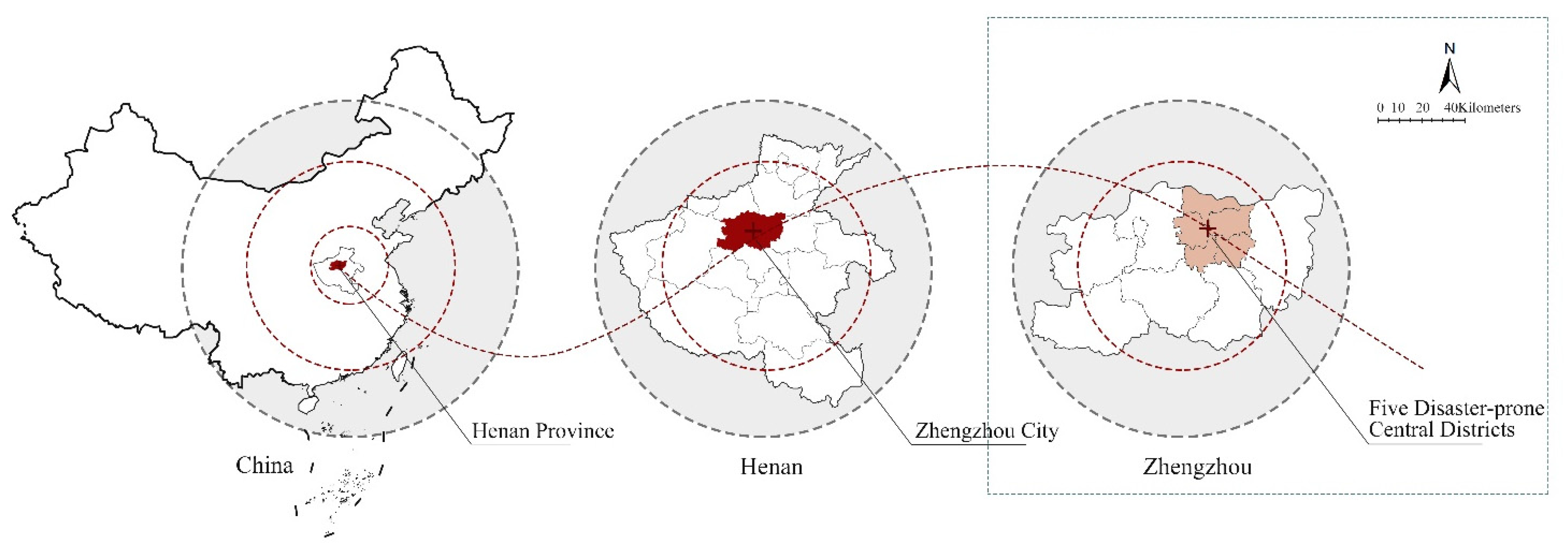
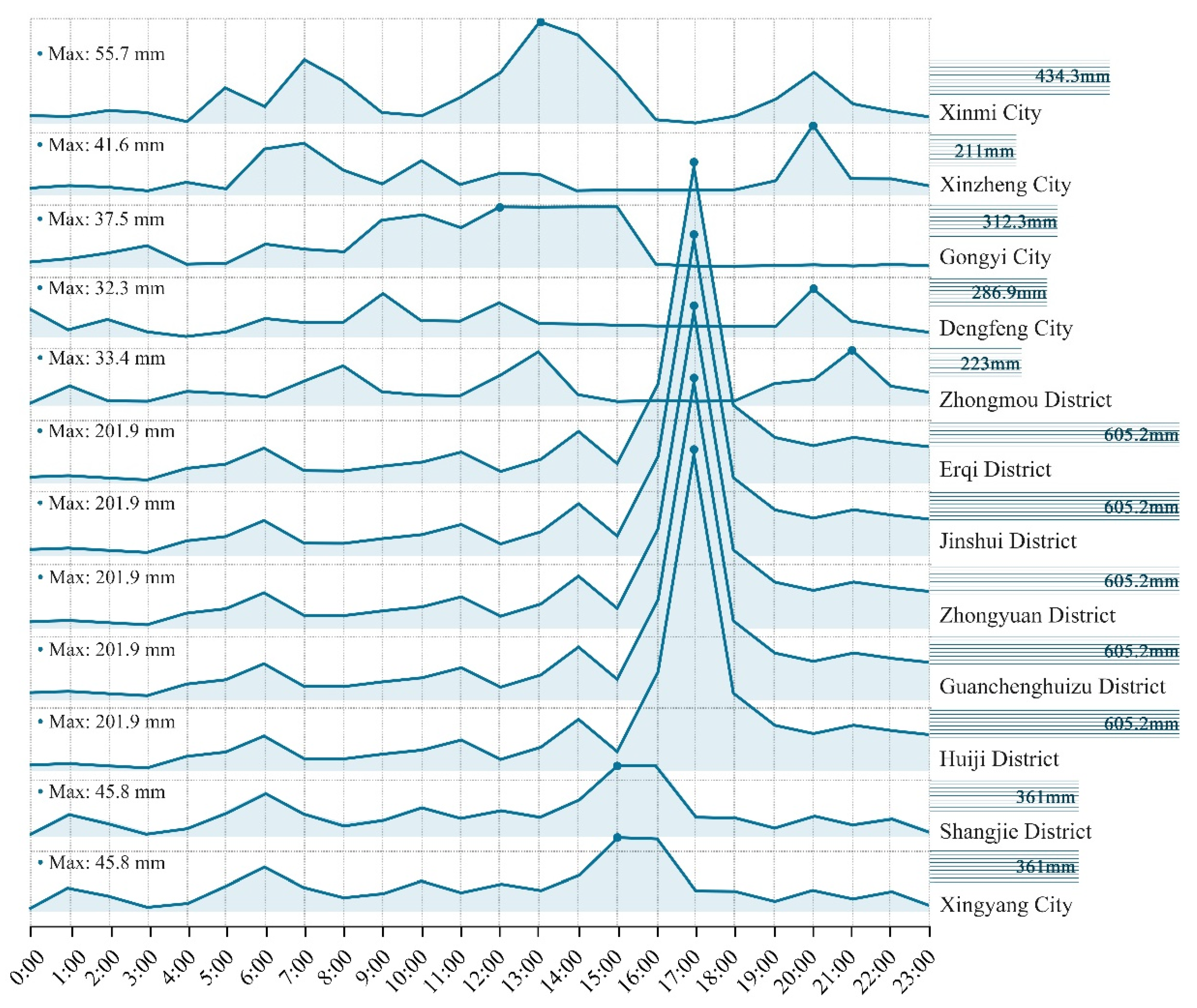
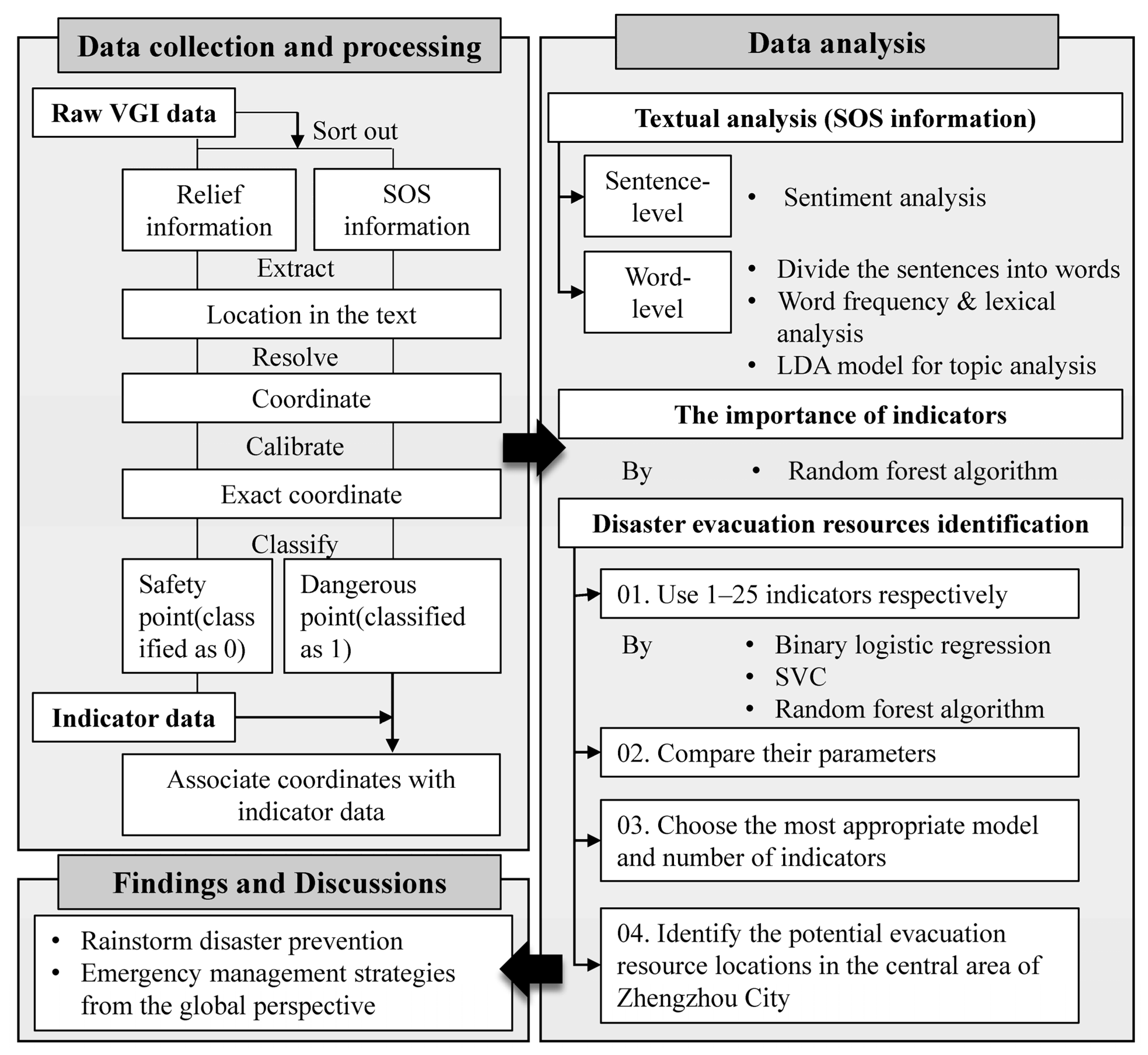
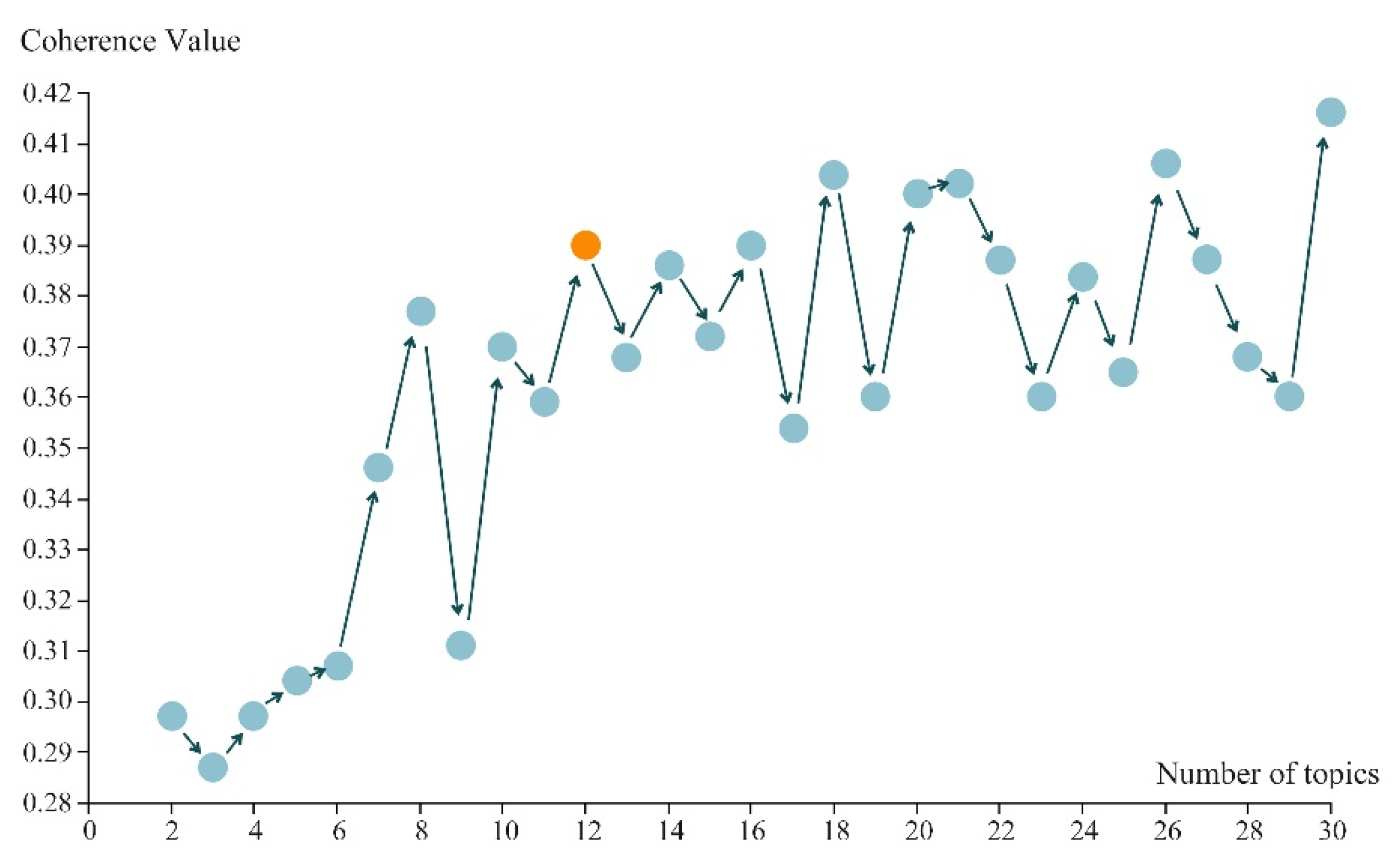
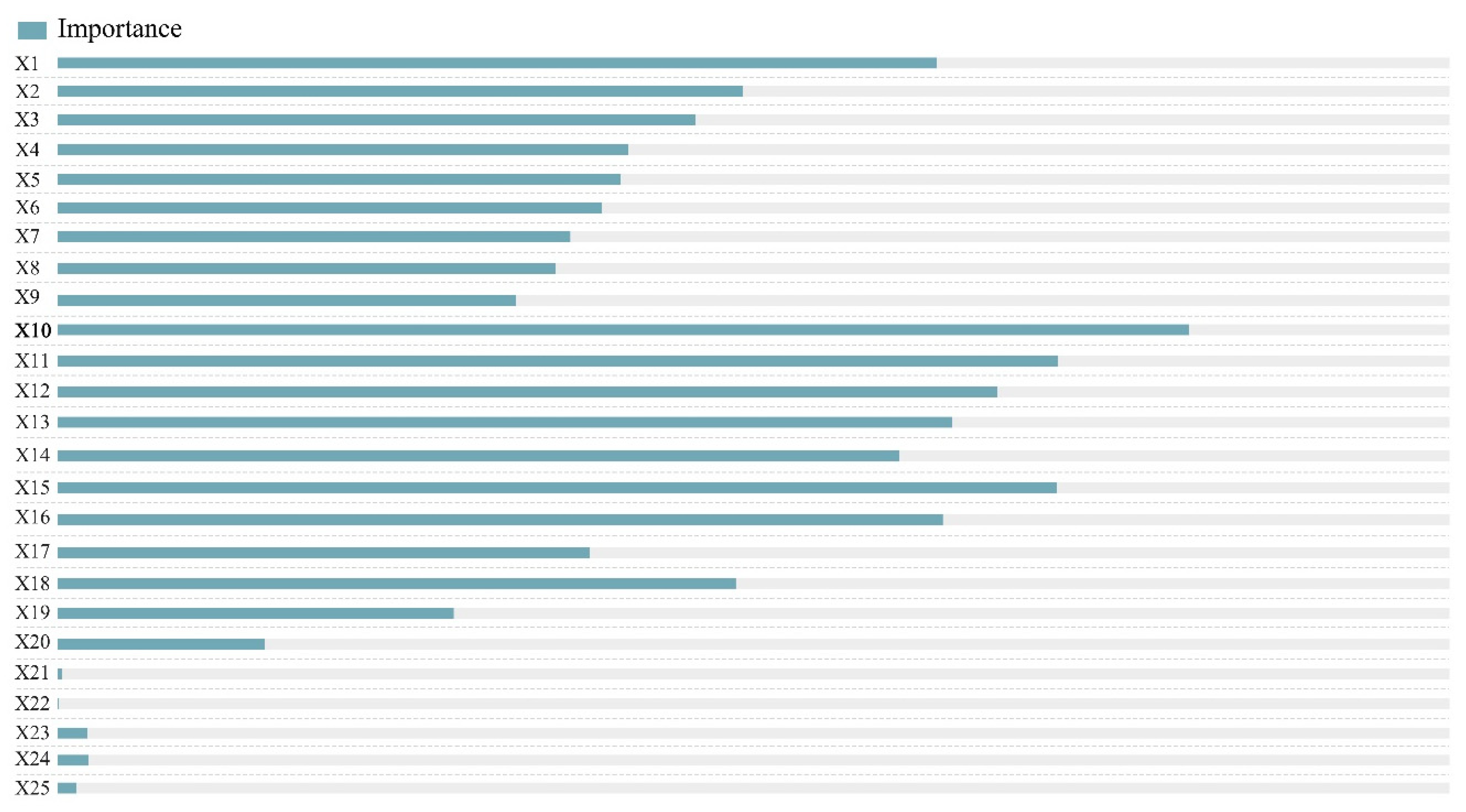
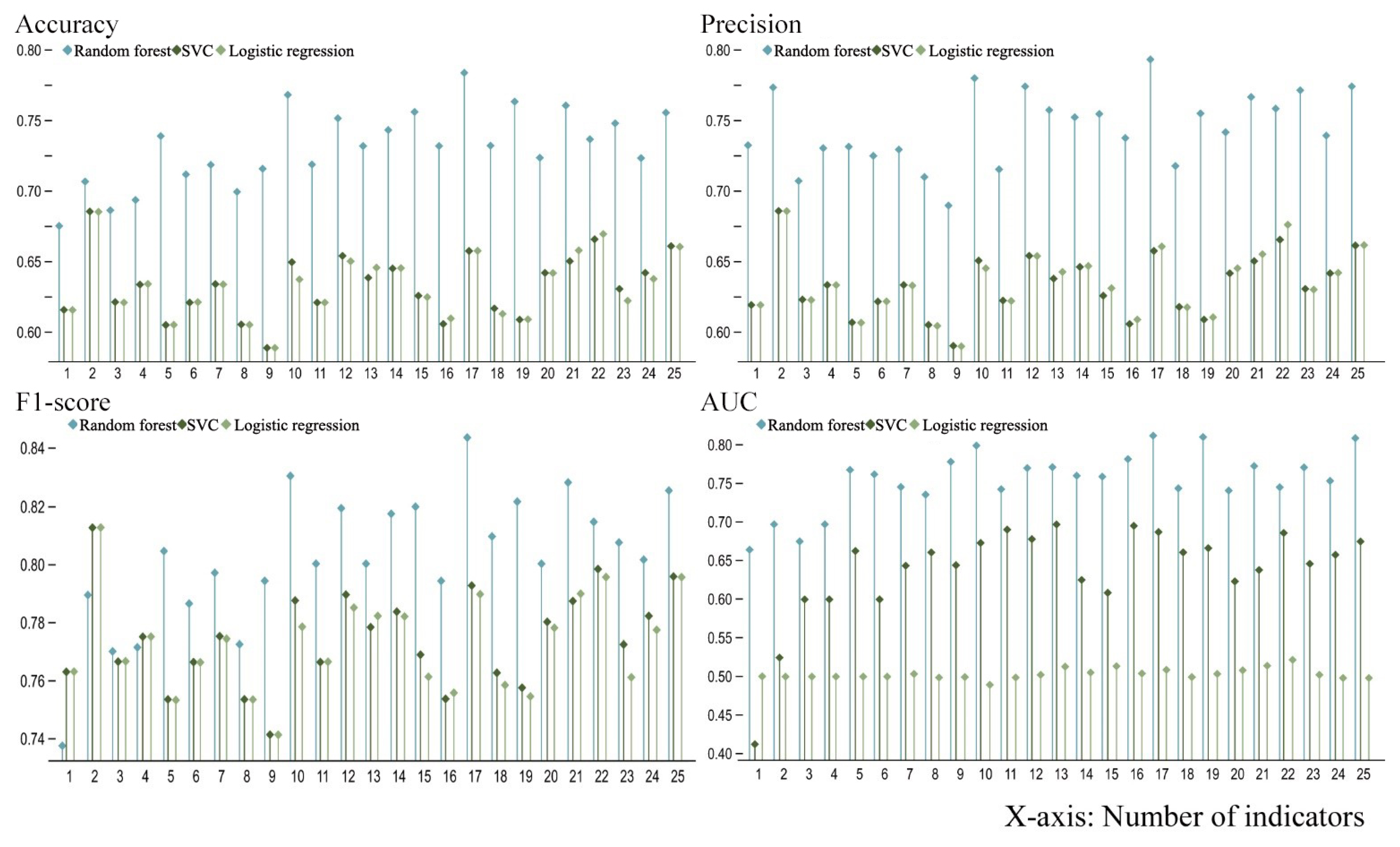
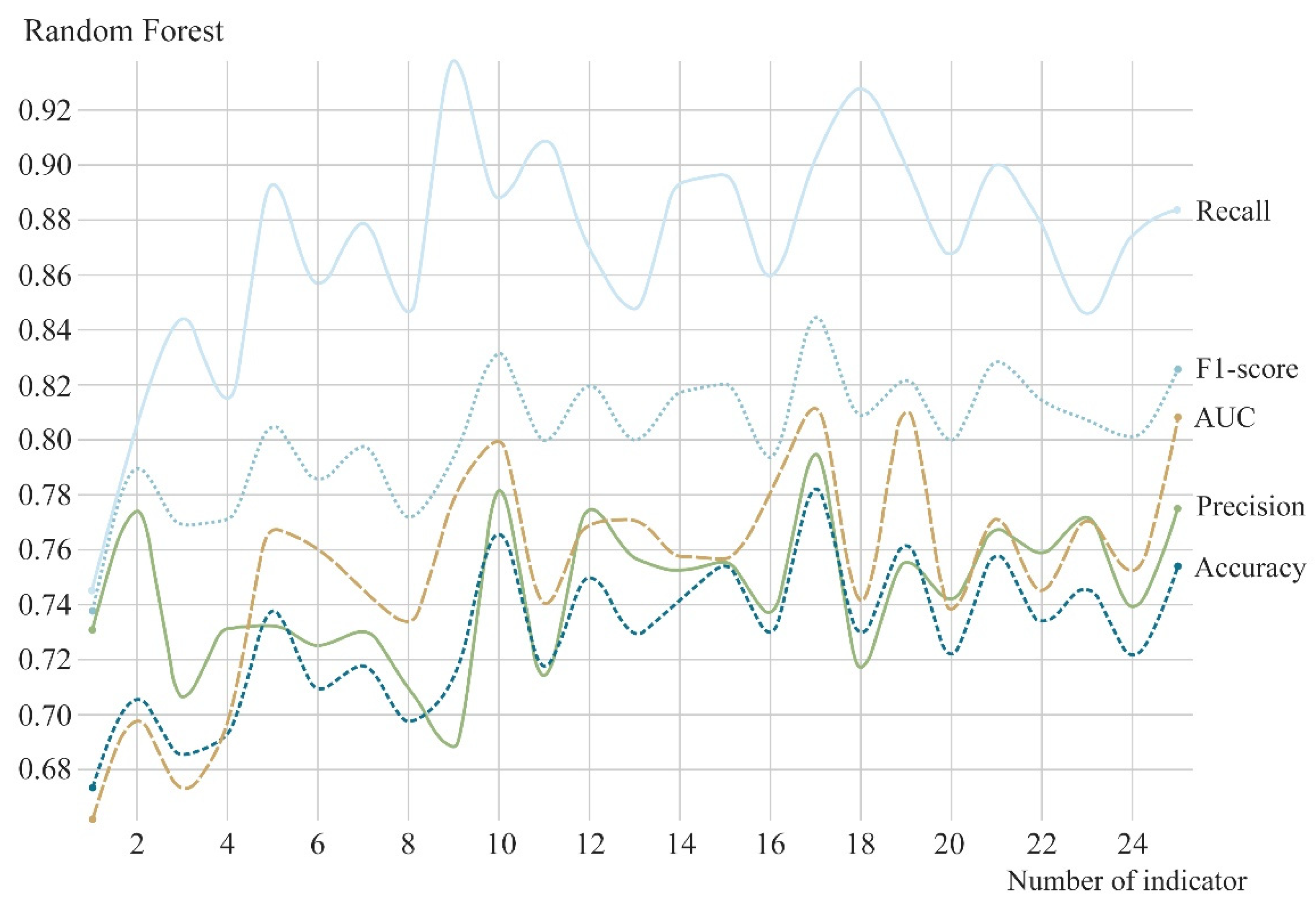

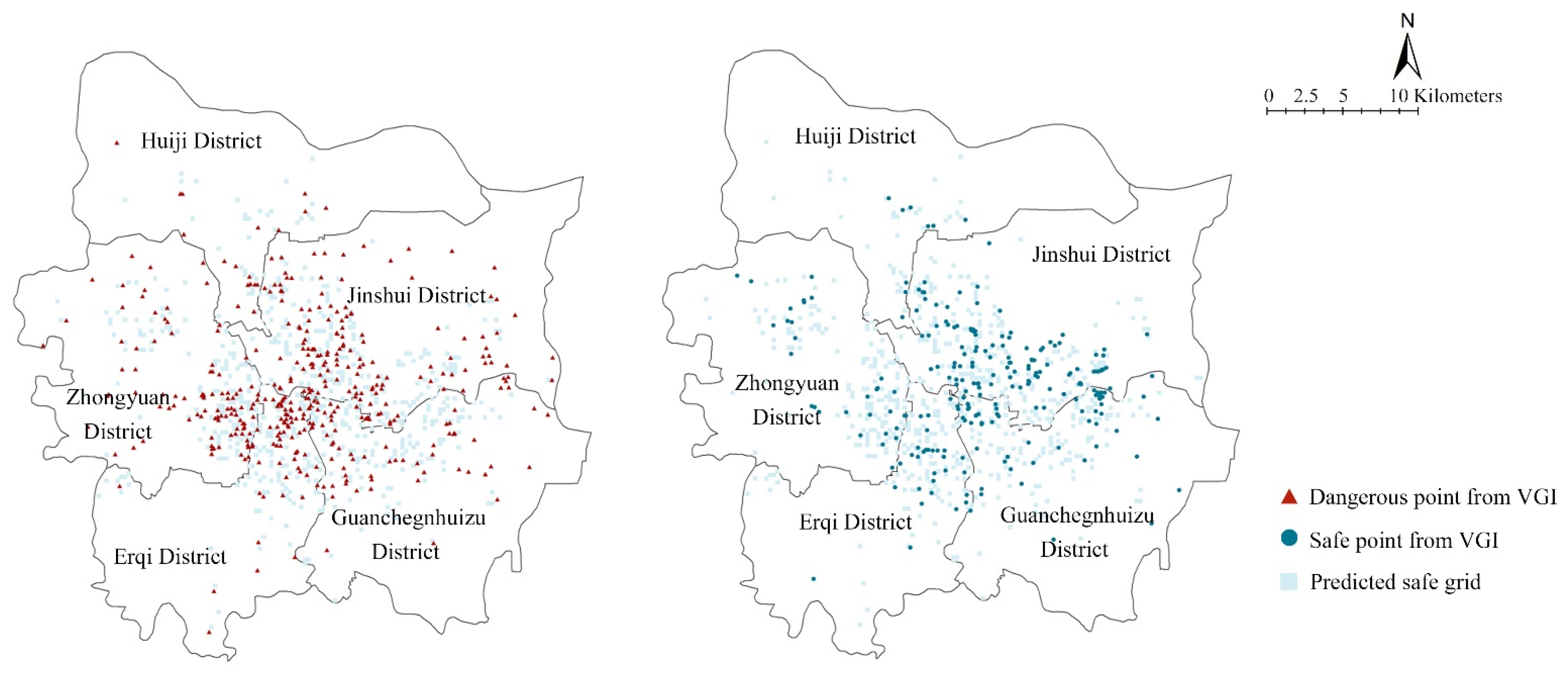
| Example 1 | Example 2 |
|---|---|
| Is there anyone at Zhengzhou East Station? Friends are trapped inside the station! The little girl has a fever and a severe headache. She does not know what to do now without medicine. There is not much battery left on her mobile phone. Contact number: XXX-XXXX-XXXX. | Address: 2 km north of Sanglin Road, Zhengkai Avenue, Zhengzhou City, in Hengze Logistics Park. Hundreds of people have been trapped for 24 h, the water level is still rising, people are already on the roof, and there is no way out! No water, no power, no food. Some people already feel unwell and ask for rescue, emergency! Urgent! |
| Category | Indicator | Description | Data Source |
|---|---|---|---|
| Distribution of facilities | (X1) POI of domestic services | Number of living service facilities in the grid | Gaode Open Platform (https://lbs.amap.com/ (accessed on 18 March 2022)) |
| (X2) POI of dining and shopping | Number of dining and shopping facilities in the grid | ||
| (X3) POI of transportation facilities | Number of transportation facilities in the grid | ||
| (X4) POI of sports and leisure facilities | Number of sports and leisure facilities in the grid | ||
| (X5) POI of government organizations | Number of government agencies in the grid | ||
| (X6) POI of science and education facilities | Number of science, education, and cultural facilities in the grid | ||
| (X7) POI of industry and enterprises | Number of industrial and business facilities in the grid | ||
| (X8) POI of financial institutions | Number of financial facilities in the grid | ||
| (X9) POI of medical institutions | Number of medical facilities in the grid | ||
| Typography | (X10) Section curvature | Section curvature at grid center point | Calculated using ArcGIS 10.8 on 30 m DEM data from Geospatial Data Cloud. |
| (X11) Elevation | Elevation at the grid center point | ||
| (X12) Plane curvature | Plane curvature at grid center point | ||
| (X13) Slope direction | Slope direction at grid center point | ||
| (X14) Slope | Slope at grid center point | ||
| Society and economy | (X15) GDP | GDP of the grid (in 2015) 1 km resolution data with spatial interpolation | Kilometer grid dataset of China’s GDP spatial distribution. The data were obtained from the Resource and Environmental Science Data Registration and Publishing System [66] |
| (X16) Population | The population of the grid Population counts/constrained individual countries 2020 UN adjusted (100 m resolution) Population data were corrected according to Official data from China’s seventh population census | WorldPop [67] | |
| Land use | (X17) Proportion of impervious surface area | Percentage of impervious surface in the grid | GISD30: global 30 m impervious surface dynamic dataset from 1985–2020 [68] |
| (X18) Road density | The density of roads in the grid | Baidu Map Open Platform | |
| (X19) Water | Area of water in the grid | ESRI: Sentinel-2 10-Meter Land Use/Land Cover | |
| (X20) Built area | Area of built area in the grid | ||
| (X21) Bare ground | Area of bare ground in the grid | ||
| (X22) Trees | Area of trees in the grid | ||
| (X23) Crops | Area of crops in the grid | ||
| (X24) Grass | Area of grass in the grid | ||
| (X25) Shrub | Area of shrubs in the grid |
| No. | Word | Count | Flag | No. | Word | Count | Flag |
|---|---|---|---|---|---|---|---|
| 1 | trapped | 172 | adjective | 15 | water lever | 32 | noun |
| 2 | rescue | 103 | verb noun | 16 | rescue team | 31 | noun |
| 3 | hour | 65 | noun | 17 | Zhengzhou | 29 | place |
| 4 | the aged | 63 | noun | 18 | 20 | 29 | numeral |
| 5 | child | 62 | noun | 19 | hope | 29 | verb |
| 6 | food | 47 | noun | 20 | personnel | 27 | noun |
| 7 | cell phone | 45 | noun | 21 | signal | 26 | noun |
| 8 | telephone | 45 | noun | 22 | water cut off | 24 | verb |
| 9 | not accessible | 39 | adverb | 23 | condition | 23 | noun |
| 10 | community | 37 | noun | 24 | friend | 23 | noun |
| 11 | power failure | 36 | verb | 25 | on the car | 22 | place |
| 12 | help | 34 | verb | 26 | no power | 22 | verb |
| 13 | urgent need | 33 | noun | 27 | materials | 21 | noun |
| 14 | lost contact | 32 | verb noun | 28 | stagnant water | 21 | noun |
| Topic No. | Keywords and Their Weights | Topic Summary |
|---|---|---|
| 1 | 0.033 × “the old” + 0.032 × “urgent need” + 0.021 × “hour” + 0.019 × “generator” + 0.012 × “one” + 0.011 × “friend” + 0.009 × “mobile” + 0.009 × “company” + 0.009 × “worry” + 0.008 × “information” | Vulnerable people, needs |
| 2 | 0.213 × “call for help” + 0.206 × “scenic area” + 0.128 × “trapped” + 0.109 × “!!” + 0.003 × “reservoir” + 0.003 × “area” + 0.003 × “place” + 0.003 × “support” + 0.003 × “section” | Trapped location |
| 3 | 0.034 × “!” + 0.017 × “child” + 0.015 × “Zhengzhou” + 0.015 × “power outage” + 0.012 × “flooded” + 0.011 × “water outage” + 0.011 × “first floor” + 0.011 × “month” + 0.011 × “day” + 0.010 × “food” | People, time, location, needs |
| 4 | 0.021 × “inside” + 0.017 × “transfer” + 0.016 × “condition” + 0.016 × “water cut off” + 0.013 × “hope” + 0.012 × “dad” + 0.011 × “one person” + 0.008 × “battery” + 0.008 × “tumor hospital” + 0.007 × “medical staff” | Medical resources |
| 5 | 0.017 × “year old” + 0.017 דthe old” + 0.013 × “water level” + 0.012 × “less than” + 0.012 × “home” + 0.011 × “water depth” + 0.011 × “landslide” + 0.011 × “occurrence” + 0.010 × “one meter” + 0.009 × “baby” | Vulnerable people, secondary disaster |
| 6 | 0.012 × “message” + 0.011 × “phone” + 0.010 × “terrain” + 0.010 × “front” + 0.010 × “five o’clock” + 0.010 × “Zhengzhou” + 0.010 × “multiple people” + 0.010 × “please“ + 0.010 × “point” + 0.009 × “height” | Information, topography, population characteristics |
| 7 | 0.018 × “hotel” + 0.018 × “power outage” + 0.014 × “water outage” + 0.014 × “thank you” + 0.014 × “signal” + 0.013 × “transfer” + 0.012 × “water” + 0.012 × “children” + 0.010 × “the old” | Location, energy, transfer |
| 8 | 0.058 × “rescue” + 0.034 × “trapped” + 0.023 × “community” + 0.020 × “no” + 0.017 × “person” + 0.017 × “water” + 0.015 × “old people” + 0.014 × “20” + 0.012 × “request” + 0.012 × “night” | Location, needs, time |
| 9 | 0.015 × “urgent” + 0.015 × “road” + 0.014 × “no access” + 0.014 × “yesterday” + 0.013 × “home” + 0.011 × “family” +0.011 × “rescue team” + 0.011 × “phone” + 0.011 × “cannot get out” + 0.010 × “place” | Rescue |
| 10 | 0.145 × “trapped” + 0.116 × “help” + 0.115 × “submerged” + 0.112 × “parking lot” + 0.011 × “hospital” + 0.010 × “tears” + 0.010 × “pregnant women” + 0.009 × “hours” + 0.008 × “floor” + 0.008 × “waiting” | Location, affected people |
| 11 | 0.061 × “!” + 0.033 × “water” + 0.022 × “car” + 0.020× “food” + 0.015 × “method” + 0.014 × “community” + 0.012 × “thank you” + 0.009 × “help” + 0.008 × “fever” + 0.008 × “true” | Mood, materials, health condition |
| 12 | 0.021 × “no access” + 0.020 × “no” + 0.020 × “mobile” + 0.016 × “no contact” + 0.015 × “no power” + 0.014 × “help” + 0.013 × “eat” + 0.010 × “hours” + 0.010 × “shutdown” + 0.009 × “bad” | Contacts |
| District | Dangerous Points from VGI | Safe Points from VGI | Predicted Safe Grids | Ratio of Predicted Safe Grids to Safe Points |
|---|---|---|---|---|
| Erqi | 76 | 39 | 117 | 3.00 |
| Guanchenghuizu | 84 | 61 | 139 | 2.28 |
| Jinshui | 156 | 140 | 203 | 1.45 |
| Zhongyuan | 110 | 40 | 143 | 3.58 |
| Huiji | 27 | 9 | 36 | 4.00 |
| Total | 453 | 289 | 638 | 2.21 |
Publisher’s Note: MDPI stays neutral with regard to jurisdictional claims in published maps and institutional affiliations. |
© 2022 by the authors. Licensee MDPI, Basel, Switzerland. This article is an open access article distributed under the terms and conditions of the Creative Commons Attribution (CC BY) license (https://creativecommons.org/licenses/by/4.0/).
Share and Cite
Gao, J.; Murao, O.; Pei, X.; Dong, Y. Identifying Evacuation Needs and Resources Based on Volunteered Geographic Information: A Case of the Rainstorm in July 2021, Zhengzhou, China. Int. J. Environ. Res. Public Health 2022, 19, 16051. https://doi.org/10.3390/ijerph192316051
Gao J, Murao O, Pei X, Dong Y. Identifying Evacuation Needs and Resources Based on Volunteered Geographic Information: A Case of the Rainstorm in July 2021, Zhengzhou, China. International Journal of Environmental Research and Public Health. 2022; 19(23):16051. https://doi.org/10.3390/ijerph192316051
Chicago/Turabian StyleGao, Jingyi, Osamu Murao, Xuanda Pei, and Yitong Dong. 2022. "Identifying Evacuation Needs and Resources Based on Volunteered Geographic Information: A Case of the Rainstorm in July 2021, Zhengzhou, China" International Journal of Environmental Research and Public Health 19, no. 23: 16051. https://doi.org/10.3390/ijerph192316051
APA StyleGao, J., Murao, O., Pei, X., & Dong, Y. (2022). Identifying Evacuation Needs and Resources Based on Volunteered Geographic Information: A Case of the Rainstorm in July 2021, Zhengzhou, China. International Journal of Environmental Research and Public Health, 19(23), 16051. https://doi.org/10.3390/ijerph192316051






